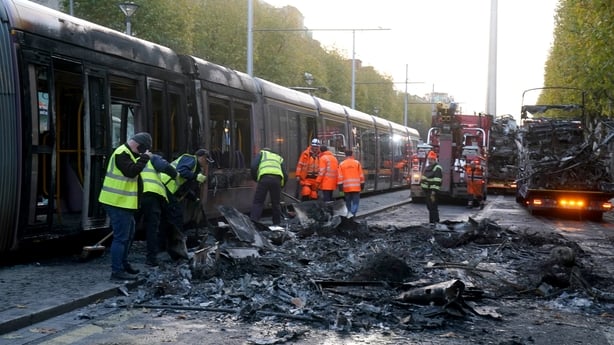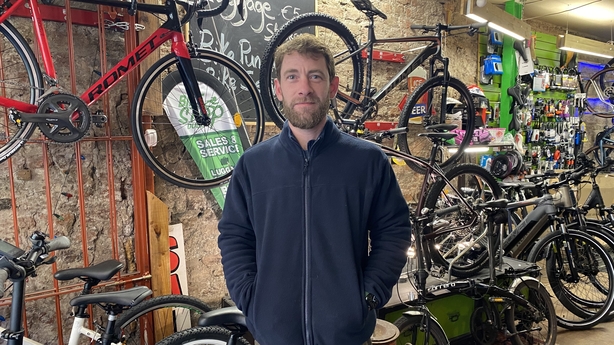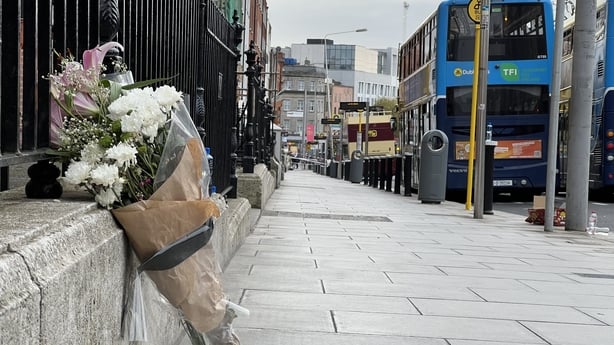A Dublin gaelscoil has said many of its pupils, staff and parents remain deeply traumatised as a result of the stabbing attack and subsequent widespread rioting and looting across the capital city last November.
It is a year to the day that a then five-year-old girl was left fighting for her life, when she was stabbed with a knife as she left her school that Thursday afternoon.
Expressing gratitude to all of those who provided help and support at the time and since, Gaelscoil Choláiste Mhuire on Parnell Square has said that the healing process will take some time yet.
The little girl, who was in Junior Infants at the time and is now aged six, was left with life-changing injuries. Whilst she was discharged from hospital two months ago, she is continuing to live with an acquired brain injury.
Her mother said in a statement issued yesterday that she and her husband have had to re-learn how to parent, whilst she has had to “re-learn being a child with extreme limitations.”
Another young girl and boy and a creche worker were injured in the same attack.
In a statement the school said: “The trauma is still very real for so many in the school community, which it said included its pupils, their parents and their staff.”
Whilst they said they understood the public and media interests in the case, the school said they would not comment further as they said they were “determined not to do anything that might re-traumatise” those caught up in the violent incident that day.
The Dublin riots were described this week by a judge during a sentence hearing at the Dublin Circuit Criminal Court as “one of the greatest examples of public disorder in the history of the state.”
The disorder initially started at the school as gardaí established a cordon around the crime scene which protesters tried to break through. It later spread across the city towards O’Connell Street and the surrounding streets and shops. Over the course of several hours, businesses were broken into, ransacked and looted.

There were also violent attacks on public transport services including the Luas and on frontline workers and emergency services who tried to help those injured.
Thirteen gardaí were among those injured.
“It was quite an exceptional incident,” explains Dr Johnny Connolly, a criminologist at the Centre for Crime and Justice and Victim Studies at the School of Law at the University of Limerick.
“There was a combination of circumstances that were probably quite unique in the sense that you had children and a care worker being attacked.”
He said the subsequent rioting also took place against a background where there had been anti-immigrant sentiment already brewing up online.
Just a week previously, there had been the conviction of foreign national Jozef Puska for the murder of the primary school teacher and talented Irish musician Ashling Murphy. Other issues, including the housing crisis, had helped to exacerbate a sense of anger towards the Government.
Social media was used to rapidly spread both information about where to meet up, as well as disinformation about the initial attack, which led to multiple people making their way towards the city centre.
“One thing that was quite exceptional was the speed with which people converged in the city centre and they weren’t all from the inner city, they weren’t all from Dublin, they were from further afield as well if we’re to take those who were brought before the courts and the various addresses.”
He said many of these individuals were not connected to each other, but they were mobilised “very rapidly.”
Dr Connolly says there was exploitation by certain far-right elements, “using the immigration issue, using the homeless issue to present their own agenda.”
He said this could be described as the “conscious opposition” or brain behind the harm that was caused.
In relation to those suspected of inciting the violence online, senior gardaí asked this week for the public’s help in identifying suspects, and said that those investigations are still ongoing at a national level. This week’s appeal was mainly for those suspected of looting or criminal damage.
The Parnell Square incident was an unprecedented attack and is to date the only such stabbing attack outside a school in Ireland.
Asked whether such an incident could happen again, Chief Superintendent Patrick McMenamin said risks and threats of potential attacks are kept under regular review and updated by garda intelligence.
Superintendent Liam Geraghty said what happened in Dublin that day and into the night was similar to what had been witnessed in other jurisdictions, including recent rioting in the UK and across Europe.
“This is not something that An Garda Síochána alone is dealing with, we clearly saw it in the UK,” he said, adding that significant rioting there had also been organised via social media and had continued for days, “much longer than it did here in this jurisdiction.”
He said in relation to any large-scale rioting incident, there would always be opportunists, some of whom engaged in looting on the night, without having been influenced by the initial call to come out.
“It was very frightening”
This was the experience of Cliff Nolan, the co-owner of Bike Stop on Capel Street, who rushed back to defend his business that night after hearing that masked rioters had broken into his shop. Within minutes ten bikes and the shop’s till had been carried out of the door.
The shop’s computer and a phone were also taken, seemingly by a passer-by who just seized the opportunity.

He and his business partner then spent the night in the shop, trying to defend their remaining stock by boarding it up with pieces of wood.
“We had to stay there that night. We didn’t know what else to do. The front was completely smashed and there was no other way, so we got lengths of wood and what not and we built a barricade, and me and my business partner Pawel stayed here for the night to secure the rest of the shop. It was very frightening.”
He says a year on, he can still feel tense and insecure, especially late at night. But overall, he says “what happened afterwards is all the neighbouring businesses and customers and people who weren’t customers before, showing so much kindness and support.”

He says his business partner from Poland and a young man from Ukraine who had been working in the shop had felt very nervous after the riots. “It was very tense in the city for a couple of weeks afterwards.”
He says it was a unique set of circumstances that kicked off the events that night and he is hopeful nothing like that will happen again. “I’m only moving forward, I’m not looking backwards at that event, to be honest.”
He said he felt a lot more connected with the community around Capel Street which was heartwarming and “really special.”
Whilst the media naturally focused on the spiral of violence ignited across the capital city, Dr Connolly says it is also important not to lose sight of this counter narrative, about the number of people who tried to help each other that day and afterwards.
They include the brave people who rushed in to try to stop the attack on Parnell Street, including Brazilian delivery driver Caio Benicio who used his helmet to hit the attacker.
“When the public began to turn against the suspect, you had other members of the public protecting the suspect from attack from the crowd,” says Dr Connolly.
As a former member of the Commission on the Future of Policing in Ireland, he says there have already been some changes since the riots when it comes to how the gardaí interact with local communities, along with an acknowledgement that many issues including crime prevention are much broader than policing alone.

The Policing and Community Safety Act passed through the Oireachtas earlier this year and following pilot schemes in Dublin, Longford and Waterford, the National Office of Community Safety has been set up,
“It’s really important that the police are totally operationally up to date with understanding problems and reacting in accordance with best practice in policing,” he says.
He said these changes are designed to promote cohesion at a community level in a bid to prevent antagonisms developing over a wide range of issues but including issues like the provision of accommodation for asylum seekers.
The Dublin City Taskforce also made recommendations last month including drafting in 1,000 additional gardaí to keep the city safe, along with other recommendations on cleaning up the city.
Dublin Town, says footfall in the city remains 2% down on last year and that a greater garda presence is needed to reassure the public in the run-up to this Christmas.
Arising out of what happened last November, Chief Supt McMenamin reflected this week that gardaí now had body-worn cameras, increased public order capacity and he said there had been increased training.
“There’s always room for lessons learned,” he said.
The family of the young girl injured in the Parnell Square attack say she is continuing to make great progress, which they don’t wish to stop. Reflecting that some people with acquired brain injuries can change and show improvement up to a decade later, they said: “Only time will truly tell.”
The family has previously said in a media interview that they do not want what happened to their daughter to be associated with the anger and hate that sprung up from the riots.
Last night in her statement, her mother said they do not wish to remember the tragedy: “We choose rebirth, triumph, resilience.”
